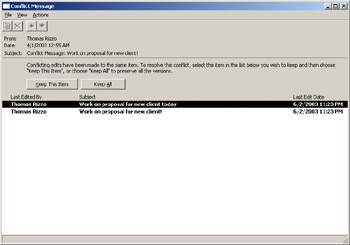Built-in Information Management Tools
Managing information in applications can be one of the most tedious tasks for a developer. But public folders, with their built-in and configurable services, will handle this for you automatically. You can set the expiration time for information in public folders, thereby preventing the folders from becoming inundated with megabytes of outdated and useless information. The conflict management features in public folders prevent two users from unintentionally saving two versions of the same document. If two users edit the same document stored in a public folder and then try to save their changes, Exchange Server will send a message about the conflict to both users and to any folder contacts defined on the public folder. The users can then decide whether to keep one of the two items or both. Figure 2-18 shows the Conflict Message dialog box.

Figure 2-18: Conflict Message dialog box
Rules
Exchange Server uses rules to help manage the massive amount of information received by an organization. Although many other collaborative systems have this functionality in some form, a user generally must be logged on to the system before rules can be processed . Also, other systems don't allow rules in folders other than a user's personal folders. With Exchange Server, rules are supported for both personal folders (such as an inbox) and for public folders.
By setting rules in your public folder application, you can to some extent control the flow of information into and out of the folder. Public folder rules are configurable by the owner of the public folder and are set up on the server, which means no client has to be logged on for the rules to fire. Instead, the server fires the rules.
The types of rules you can create range from simple rules, such as "send a thank you e-mail to anyone who sends a message to the public folder," to very complex rules. Complex rules can entail checking multiple fields on an item and taking a specific action based on those fields.
Server Events
With Exchange 2000 and 2003, the Exchange 5.5 event scripting agent applications still work, but you must enable the event service (which is disabled by default in Exchange 2000 and 2003). Also, new and more powerful server events are available. Chapter 17 covers events in more detail, but you can use the full power of COM or .NET applications to capture server-side events such as items being created or deleted and perform your own business logic on these items.
EAN: 2147483647
Pages: 227